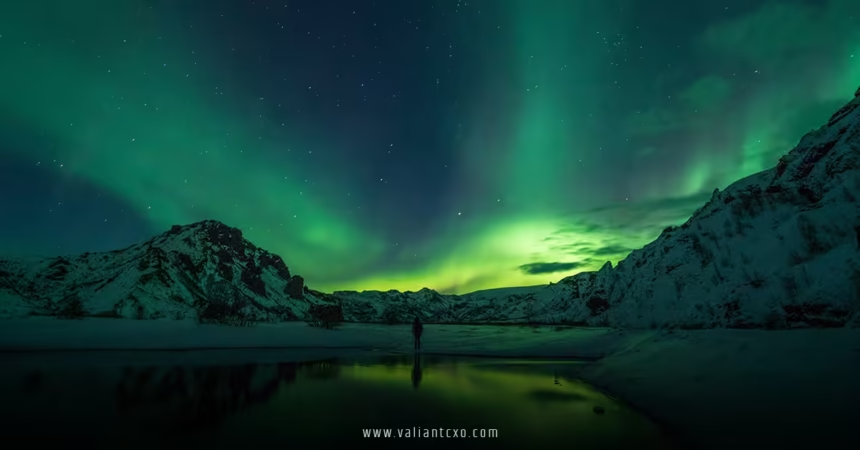Butterfly shaped hole on the sun? Yeah, you read that right—it’s not some sci-fi plot twist, but a real cosmic spectacle that’s got astronomers buzzing and aurora chasers gearing up. Picture this: our massive, fiery star sporting a gaping void that looks eerily like delicate wings spread wide. Spotted just a few days ago, this isn’t your everyday solar freckle. It’s a massive coronal hole, clocking in at over 500,000 kilometers across— that’s wider than 35 Earths lined up like impatient commuters. As we sit here on September 15, 2025, the ripple effects are already teasing our planet, promising a weekend of shimmering lights in the northern skies. Buckle up, because I’m diving deep into what this butterfly shaped hole on the sun means for us Earthlings, blending hard science with that wide-eyed wonder we all feel when the universe flexes.
What Exactly Is a Butterfly Shaped Hole on the Sun?
Let’s kick things off with the basics, shall we? If you’re like me, staring at the sun (safely, through filters, of course) feels like peeking into a cosmic oven. But this butterfly shaped hole on the sun? It’s no burn mark—it’s a window into the star’s wild magnetic personality. At its core, we’re talking about a coronal hole, those shadowy patches in the sun’s outer atmosphere, the corona, where things get a tad cooler and less dense than the blazing surroundings.
Unpacking Coronal Holes: The Sun’s Secret Vents
Imagine the sun as a pressure cooker with magnetic fields twisting like overcooked spaghetti. Normally, those fields loop back on themselves, trapping hot plasma in a fiery embrace. But in a coronal hole, the fields fling open like unlocked gates, letting that superheated gas—whoosh!—stream out as solar wind at breakneck speeds. These holes show up dark in extreme ultraviolet images because they’re not glowing as fiercely; the plasma there chills to around a million degrees Kelvin, a “mere” fraction of the corona’s usual inferno.
Why do they form? Blame the sun’s 11-year cycle of tantrums. During solar minimum, when the star’s magnetic flip-flopping calms down, these holes balloon near the poles, sometimes stretching equator-ward like lazy rivers. Our butterfly shaped hole on the sun, though? It’s equatorial, a rare bird in this solar maximum phase we’re riding now, where sunspots and flares usually steal the show. It’s like the sun decided to doodle a whimsical shape amid its usual chaos.
Why This One Looks Like a Butterfly: Shape-Shifting Solar Drama
Now, the million-dollar question: why butterfly? Not a heart, not a star—wings. This particular butterfly shaped hole on the sun emerged with perfect symmetry, its “wings” spanning that jaw-dropping 500,000 km, as captured by NASA’s Solar Dynamics Observatory on September 11, 2025. Scientists reckon it’s the result of tangled magnetic fields unraveling in a balanced tug-of-war, creating those twin lobes that mimic a monarch mid-flutter. It’s not just pretty; that shape funnels solar wind straight at us, like a cosmic hose aimed dead-on. Coincidence? Or the universe’s way of saying, “Hey, look up—I’ve got a show for you”?
Rhetorically speaking, doesn’t it make you ponder how something so vast can mimic something so fragile? A hole big enough to swallow our planet whole, yet delicate as lace. That’s the sun for you—brutal and beautiful in equal measure.
The Thrilling Discovery of the Butterfly Shaped Hole on the Sun
Hold onto your telescopes, because spotting this butterfly shaped hole on the sun was pure serendipity wrapped in cutting-edge tech. NASA’s Solar Dynamics Observatory (SDO), that tireless eye in the sky launched back in 2010, snapped the first clear shots on September 11. There it was: a dark, winged void staring back from the sun’s southern hemisphere, facing Earth like it had front-row seats to our world.
From Spacecraft Snapshots to Global Buzz
Astronomers at NOAA’s Space Weather Prediction Center lit up with alerts almost immediately. “Whoa, check this out,” I can imagine them saying in the control room. The SDO’s instruments, tuned to extreme ultraviolet wavelengths, painted the hole in stark contrast against the sun’s roiling plasma. By September 12, images flooded social media—Reddit threads exploding with “Is this real?” posts, and X (formerly Twitter) timelines fluttering with butterfly emojis. It’s moments like these that remind us science isn’t stuffy labs; it’s live, electric discovery.
What sealed the deal? Models like NOAA’s WSA-Enlil simulated the solar wind’s path, confirming it’d slam into Earth’s magnetosphere by September 14. No wonder the buzz hit fever pitch— this wasn’t a distant curiosity; it was inbound.
Tech That Made It Possible: Shoutout to Solar Sentinels
We owe this peek to a fleet of solar sleuths: SDO for the visuals, GOES satellites for real-time monitoring, and even the Parker Solar Probe, zipping closer to the sun than Mercury’s orbit. These tools demystify the corona, once only visible during eclipses. Back in the day, folks like me would squint at sketches from 19th-century eclipse chasers. Now? High-res feeds straight to your phone. Wild, right?
How the Butterfly Shaped Hole on the Sun Shakes Up Earth
Alright, let’s get personal—how does this distant solar graffiti mess with our daily grind? Spoiler: it’s not all doom; there’s dazzle too. The butterfly shaped hole on the sun is pumping out fast solar wind, clocking 450-800 km/s, way zipier than the usual breeze. When that hits our magnetic shield, sparks fly—literally.
Solar Wind Rush: The Butterfly’s Breath on Our Back
Think of solar wind as the sun’s exhale: protons, electrons, and magnetic vibes hurtling through space. From this butterfly shaped hole on the sun, it’s a high-speed gust, carving corotating interaction regions (CIRs) as it butts against slower streams. These CIRs compress Earth’s magnetosphere, kicking off geomagnetic storms rated G1 (mild jitters) to G2 (moderate mood swings).
By September 13-14, forecasts nailed it: G1 conditions peaked, with whispers of G2 if the magnetic alignment clicked just right. Satellites glitch, GPS wobbles, power grids hum uneasily—but hey, that’s the price of cosmic connection.
Aurora Magic: Dancing Lights from the Butterfly Shaped Hole on the Sun
And then, the payoff: auroras. Those charged particles dive into our atmosphere, tangoing with oxygen and nitrogen to paint the sky green, purple, red. Thanks to the Russell-McPherron effect—a fancy tilt in magnetic fields near equinoxes like our September 22 showdown—this butterfly shaped hole on the sun amplified the show. Lights rippled as far south as northern U.S. states and the UK, turning backyards into light festivals.
I remember chasing auroras once in Iceland; the sky pulsed like a living heartbeat. This event? Reports flooded in from Alaska to Scotland, folks snapping pics under streetlights. If you missed it, don’t sweat—solar max means more encores.
Predicting Auroras Triggered by the Butterfly Shaped Hole on the Sun
Ever wish you could forecast a fireworks show? Space weather pros do it daily, and this butterfly shaped hole on the sun handed them a golden script. Tools like the Enlil model plot the wind’s trajectory, factoring speed, density, and Bz (that south-north magnetic flip crucial for storm strength).
Forecast Finesse: From Models to Midnight Hunts
For September 13-14, UK Met Office called active skies with G2 potential; NOAA played it safer at G1. Spot on—the winds arrived punchy, birthing widespread auroras. Pro tip: Apps like Aurora Alerts ping your phone when Kp index (storm measure) climbs. But prediction’s part art; solar wind’s whims can surprise.
What if you’re planning a chase? Head north, dim skies, patience. This butterfly shaped hole on the sun taught us: even pros hedge bets, but the thrill’s in the uncertainty.
Long-Term Vibes: What the Butterfly Shaped Hole on the Sun Tells Us
Zoom out—this isn’t isolated. Coronal holes like our butterfly signal solar cycle peaks, hinting at flare-filled months ahead. Monitoring them? Key to shielding tech from blackouts. It’s like having a solar mood ring.
The Science Deep Dive: Magnetic Mayhem Behind the Butterfly Shaped Hole on the Sun
Let’s geek out. The sun’s a dynamo, its convection zone churning plasma that twists fields into knots. In coronal holes, those knots snap open, unipolar fields beaming out. Our butterfly shaped hole on the sun? Likely born from a neutral line where opposite polarities canceled, birthing symmetric wings.
Plasma Physics: Cool Spots in a Hot Mess
Plasma here dips low—tenuous wisps at 10^8 particles per cubic cm versus the corona’s bustle. That lets wind accelerate via Alfvén waves, those magnetic ripples surfing particles outward. Analogy time: like wind through a mountain pass, funneled and fierce.
X-ray views from Hinode or NuSTAR reveal the hole’s edges fizzing with mini-flares, boundaries where closed fields fight open ones. Fascinating? Absolutely. It’s the sun’s architecture laid bare.
Equinox Boost: Why Now for the Butterfly Shaped Hole on the Sun
Enter Russell-McPherron: Earth’s axial tilt warps the interplanetary field southward, slipping under our magnetopause like a sly fox. Paired with this butterfly shaped hole on the sun’s timely blast, it’s storm fuel. Studies show equinoxes double disturbance odds—cozy timing for September’s show.
Historical Echoes: Other Coronal Holes Through Time
This butterfly shaped hole on the sun steals headlines, but it’s got predecessors. First spied in 1960s X-rays, holes puzzled boffins till Skylab’s 1973 views cracked the code: open fields, fast winds.
Legends of the Corona: From Eclipses to Space Age
Eclipse sketches from 1800s hinted at dark blobs amid streamers. The 1979 giant polar hole birthed the “Halloween Storms” of 2003—G5 gales blacking out Sweden. No butterflies then, but shapes varied: elephant trunks, polar caps.
Our 2025 butterfly? Rarest form yet, per records—no exact matches, though symmetric equatorial holes popped in 2012’s max. Each teaches: the sun evolves, and we’re wiser watchers.
Lessons from the Past: Prepping for Future Butterfly Shaped Holes on the Sun
History screams resilience—grids hardened post-1989 Quebec blackout. Today, AI crunches data for alerts. Next butterfly shaped hole on the sun? We’ll be ready, chasing lights with better gear.
Spotting the Glow: How to Witness Effects from the Butterfly Shaped Hole on the Sun
Missed the show? No sweat—auroras linger in replays, and more holes brew. Grab binoculars, flee city glow, aim north post-sunset.
Gear Up: Apps, Cameras, and Clear Skies
Apps like My Aurora Forecast track Kp; cameras on tripods snag timelapses. For the butterfly shaped hole on the sun itself? Solar scopes or live NASA streams—never naked-eye stare.
Pro hack: Join communities on Reddit’s r/aurora. Shared stories beat solo hunts.
Global Hotspots: Where the Butterfly Shaped Hole on the Sun Lit Up the World
Alaska’s Fairbanks glowed emerald; Iceland’s rings framed greens. Even Ohio glimpsed hints. Southern flips? Rare, but Tasmania teased reds.
It’s communal joy—strangers bonding under alien lights from a butterfly shaped hole on the sun.
Wrapping Up the Wings: Key Takeaways from the Butterfly Shaped Hole on the Sun
Whew, what a ride! This butterfly shaped hole on the sun, a 500,000-km marvel unveiled September 11, 2025, blasted solar wind our way, stirring G1-G2 storms and auroral symphonies September 13-14. We’ve unpacked coronal quirks, magnetic dances, and equinox magic, seeing how our star’s whims ripple to Earth. It’s a reminder: the cosmos connects us, turning plasma voids into sky poetry. So next time you glimpse northern lights, tip your hat to that distant butterfly—it’s fluttering reminders that wonder’s always overhead. Chase it; the universe rewards the curious.
Frequently Asked Questions (FAQs)
What causes a butterfly shaped hole on the sun?
A butterfly shaped hole on the sun forms when the star’s magnetic fields open symmetrically, creating a low-density coronal region that escapes as fast solar wind. It’s rare, shaped by balanced polarities unraveling.
Will the butterfly shaped hole on the sun cause more auroras soon?
Absolutely—lingering effects from the September 2025 event could spark minor displays through mid-month, but watch solar forecasts for fresh holes promising bigger shows.
Is the butterfly shaped hole on the sun dangerous for Earth?
Not directly, but its solar wind can trigger geomagnetic storms, mildly disrupting tech like satellites. No doomsday, just a nudge to backup your data.
How big is the recent butterfly shaped hole on the sun compared to Earth?
This one’s a beast at 500,000 km wide—over 35 times Earth’s diameter, big enough to fit dozens of our blue marble inside its wings.
Can I see the butterfly shaped hole on the sun with my own eyes?
Nope, it’s invisible without specialized telescopes like NASA’s SDO. But its aurora handiwork? Prime viewing under dark northern skies.
Read Also:valiantcxo.com


